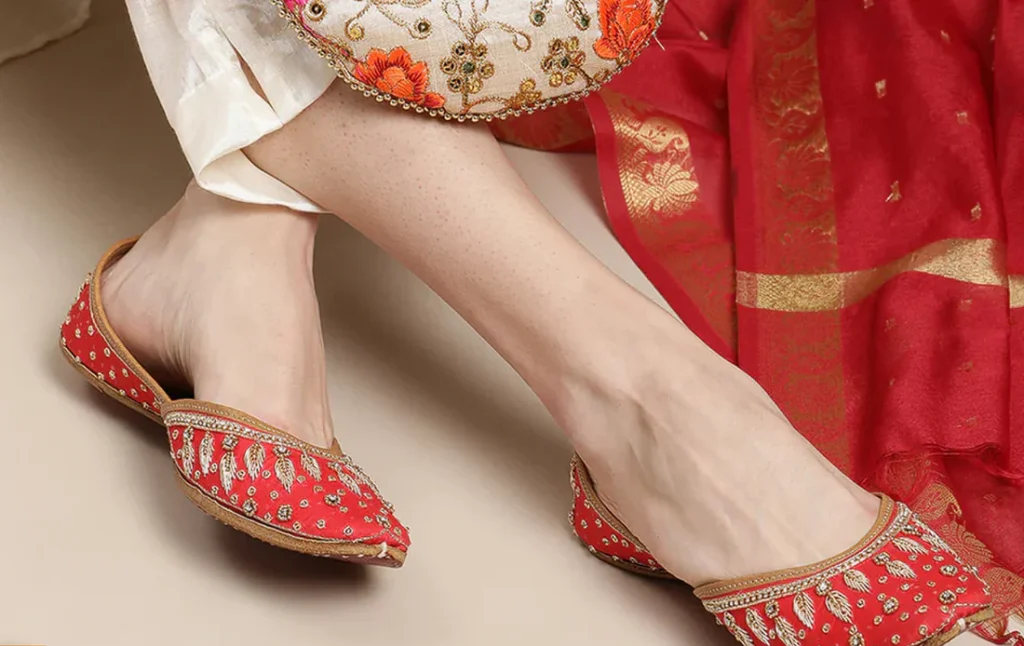Shoes are not only functional but also a symbol of identity, culture, and history. Out of all the different kinds of shoes made in the globe, Tarusi is a distinctive and culturally significant style. This essay delves deeply into the intriguing realm of Tarusi, examining its beginnings, development, and relevance in both historical and contemporary settings.
The Origins Of Tarusi

Tarusi history dates back many centuries, with its origins in areas renowned for their intricate cultural mosaic. These shoes were originally made for functionality, but over time they came to have a profound cultural meaning. Early Tarusi were frequently crafted from materials that could be found nearby, signifying the people’s ties to their land.
Evolution Through The Ages
Traditionally manufactured from plant fibres and animal hides, Tarusi were a practical yet basic foot protection item against harsh environments, demonstrating the ingenuity of prehistoric people.
Medieval Period
Intricate decorations started to be seen on Tarusi during the mediaeval period. Their intricate designs and decorations, which denoted wealth and distinction, turned them into a symbol of social standing.
Modern Adaptations
Tarusi have changed significantly in the contemporary era. They have combined the old and the new, keeping its historic character while being updated to fit current fashion trends.
Materials And Craftsmanship
Traditionally, Tarusi were made from natural materials such as leather, wool, and cotton. These materials were chosen for their durability and comfort, reflecting the ingenuity of traditional craftsmanship.
Modern Materials
While many craftspeople still work with traditional materials today, synthetic materials and cutting-edge textiles are becoming more and more popular. With this combination, Tarusi can continue to honour its legacy while serving a broader clientele.
Craftsmanship Techniques
Making Tarusi requires painstaking attention to detail in craftsmanship. Expert craftspeople utilise inherited methods to guarantee that every pair is a unique piece of art. Every detail, from delicate embroidery to hand stitching, is expertly made.
Design And Aesthetics
Vibrant colours and elaborate patterns define traditional Tarusi designs. These patterns frequently have symbolic connotations that relate to different cultural aspects and narratives.
Modern Influences
Tarusi in the modern era have embraced current fashion trends. Designers play around with hues, patterns, and materials to produce cutting-edge looks that honour classic aesthetics while appealing to a younger audience.
Unique Aesthetic Elements
Tarusi’s style is what really sets them apart. Shoes that are distinguished by their beauty and cultural importance are the product of a fusion of traditional and modern influences.
Cultural Symbolism
Tarusi’s style is what really sets them apart. Shoes that are distinguished by their beauty and cultural importance are the product of a fusion of traditional and modern influences.
Role In Rituals And Ceremonies
In many traditional rites and celebrations, tarasi have a major part. They serve as a symbol of tradition and heritage and are frequently worn during weddings, festivals, and other significant occasions.
Tarusi In Folklore
Tarusi are frequently mentioned in folklore and legends, underscoring their significance in cultural traditions. These anecdotes highlight the distinctive footwear’s cultural significance and enduring popularity.
Regional Variations
Tarusi differ greatly amongst geographical locations. Every location contributes something special, shaped by customs, environment, and resources that are available.
Influences Of Local Cultures
Local customs have a big impact on Tarusi’s architecture and construction. The diversity of styles across the varied cultural landscape, from the highlands to the coastal areas, is reflected.
Notable Regional Styles
Certain areas are especially well-known for their Tarusi fashions. These looks have become well-known due to their unique qualities and superb craftsmanship.
Tarusi In Contemporary Fashion
Tarusi have had a big influence on contemporary style. Fashion designers and aficionados love them for their distinctive styles and diverse ethnic influences.
Celebrities And Tarusi

Numerous celebrities have been observed donning Tarusi, which has elevated this traditional footwear to a global prominence. Tarusi has become more well-known outside of their native culture thanks to their support.
Designer Collaborations
To produce their exclusive Tarusi collections, traditional artisans and high-end designers have teamed up. These partnerships attract a worldwide audience by fusing heritage and luxury.
Sustainability And Ethical Production
Traditionally, local materials were used for Tarusi manufacture, along with waste-reduction techniques to ensure sustainability. Many conventional activities still adhere to this ecological mindset today.
Modern Sustainable Approaches
In response to consumer expectations for sustainability, contemporary Tarusi manufacturers are progressively implementing eco-friendly production techniques and eco-friendly materials.
Ethical Production Practices
Providing craftspeople with decent working conditions and salaries is essential. Numerous brands prioritise ethical production, community support, and the preservation of traditional crafts.
The Role Of Tarusi In Identity And Expression
One way to convey one’s heritage and sense of self is through wearing tarusi. Many see it as a celebration of their cultural heritage and a way to stay connected to their roots.
Social Status
In the past, a person’s Tarusi’s complexity can reveal their social standing. Even if it isn’t as popular as it once was, some cultures still value this tradition.
Artistic Expression
Another means of artistic expression is through tarasi. Each set of earrings is a wearable work of art due to the intricate patterns and vivid colours, which showcase the artists’ originality and talent.
The Global Influence Of Tarusi
Tarusi have become more well-known all over the world because of their distinctive fusion of modernism and heritage. People who respect handcrafted craftsmanship and cultural diversity will find them appealing.
Cultural Exchange
Due to the widespread fascination with Tarusi, there has been an increase in cross-cultural understanding and acceptance of this traditional footwear.
International Appreciation
The widespread admiration for Tarusi underscores the allure of exquisitely produced, culturally diverse objects. They act as a link across civilizations, encouraging appreciation and respect for one another.
How To Incorporate Tarusi In Your Wardrobe
Adding Tarusi pieces to your wardrobe can be a fashionable and enjoyable way to show off your individuality. Dress them up for formal events or wear them with casual attire for a stylish, boho aesthetic.
Occasions To Wear Tarusi
Tarusi are sufficiently adaptable to be worn in a variety of settings. They give an element of ethnic flair to any ensemble, whether worn for special occasions or daily wear.
Maintenance And Care
Regular maintenance is crucial to maintaining the finest possible appearance for your Tarusi. To guarantee longevity, treat them carefully, store them appropriately, and clean them with the right products.
Challenges Facing The Tarusi Industry
The loss of traditional skills and competition from mass-produced footwear are two issues facing the Tarusi industry. The craft is being preserved and these problems are being addressed.
Preservation Of Tradition
It is essential to keep up the customs surrounding the production of Tarusi. Encouraging efforts to teach upcoming craftspeople and record age-old methods are essential to retain this cultural legacy
Economic Factors
The cost of labour and materials are two economic aspects that impact Tarusi’s pricing and production. It is a constant struggle to strike a balance between cost and just remuneration for craftspeople.
Innovations In Tarusi
Tarusi is making sure it stays relevant in the contemporary market with innovations in design and production methods. The custom is being preserved by innovative designs and new materials.
Market Trends
Handmade, culturally relevant products are becoming more and more in demand. Tarusi are in a good position to profit from this trend since they appeal to customers who appreciate handiwork and authenticity.
The Future Of Traditional Craftsmanship
Given the growing interest in Tarusi traditional craftsmanship worldwide and the initiatives being made to conserve and promote it, the future of this craft is bright. It is crucial to keep supporting artists and cultural heritage.
Conclusion
Tarusi are more than simply shoes; they are an artistic expression of the producers’ artistry, a cultural journey, and a symbol of legacy. Their distinctive beauty and cultural significance guarantee that they will always be a popular style of footwear, even as they change and adapt to modern life.
FAQs
What Makes Tarusi Unique?
Tarusi are unique due to their intricate designs, cultural symbolism, and the traditional craftsmanship involved in their making. Each pair reflects a rich heritage and artisanal skill.
How Do I Maintain My Tarusi Shoes?
Maintain your Tarusi by cleaning them with appropriate products, storing them in a cool, dry place, and handling them with care. Regular maintenance will ensure they last for years.
Can Tarusi Be Worn For Formal Events?
Yes, Tarusi can be worn for formal events. Their elegant designs and cultural significance make them suitable for weddings, ceremonies, and other special occasions.
Where Can I Buy Authentic Tarusi?
Authentic Tarusi can be purchased from traditional artisans, specialty stores, and online platforms dedicated to cultural and artisanal products. Ensure you buy from reputable sources to support ethical practices.
Are Tarusi Shoes Comfortable For Daily Wear?
Tarusi are designed for comfort and durability. They can be worn daily, offering both style and practicality. However, comfort may vary depending on the specific design and materials used.
We appreciate you visiting our blog! Please feel free to browse the related category for more fascinating information.


